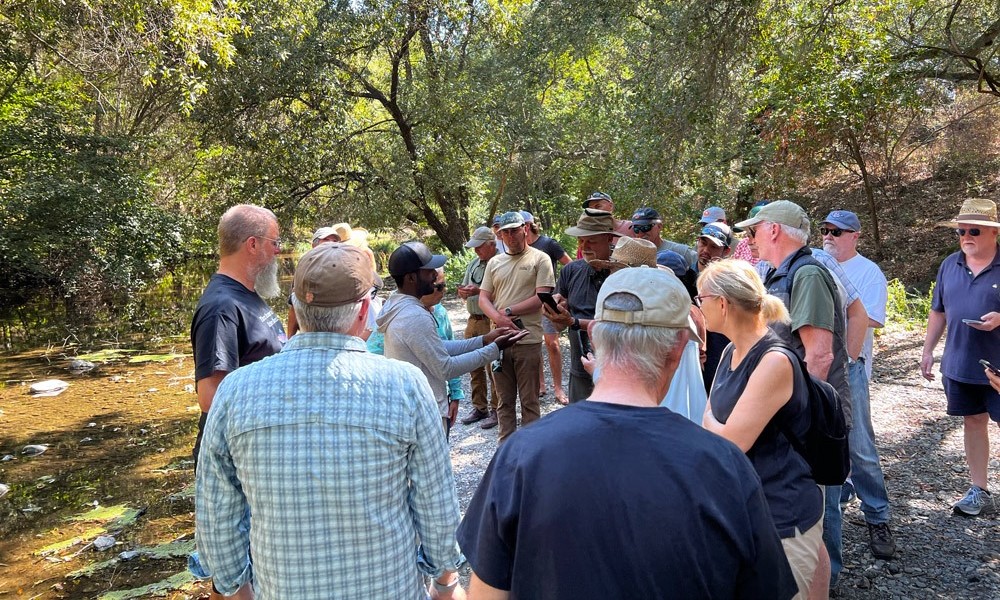In 2022, for the first time in over fifty years, Chinook salmon and steelhead were able to swim through Niles Canyon and access the upper Alameda Creek watershed near the town of Sunol, California.
Soon, these fish will be able to consistently swim even further upstream. CalTrout recently was invited to lead a gas pipeline barrier removal project in Sunol Valley to open more than 20 additional miles of stream to fish migration.
How will the barrier problem be addressed? The gas pipeline will be lowered approximately 17 feet beneath the creek bed, so it no longer protrudes above the creek.
Of course, this is how the engineers should have designed the pipeline to begin with, which would have prevented half a century of environmental damage. But these engineers were employed by PG&E, the criminal corporation of Erin Brokovich infamy, so responsible behavior was not on the menu.
Alameda Creek is the largest local tributary to the San Francisco Bay and historically produced the largest numbers of Chinook salmon, lamprey, and steelhead in the South Bay.
It is also the ancestral lands of the Muwekma Ohlone people, who depended upon the creek for water, food, shelter.
The watershed was the site of numerous permanent settlements. In 2022, former barriers at the BART weir and inflatable bladder dams in Fremont were made passable by fish due to newly constructed fish ladders by the Alameda County Water District.
This incredible opportunity for salmonids to migrate throughout the Alameda Creek watershed was the product of decades of hard work to improve fish passage by a myriad of partners in the longstanding Alameda Creek Fisheries Work Group, including the Alameda County Water District (ACWD) and Alameda County Flood Control & Water Conservation District, Alameda Creek Alliance (ACA), California Department of Fish and Wildlife (CDFW), San Francisco Public Utilities Commission (SFPUC), Zone 7 Water District, Alameda County Resource Conservation District, Trout Unlimited and the National Marine Fisheries Service, among others.
CalTrout staff have engaged in the Fisheries Work Group since 2019 and say they are thrilled to continue this hard work of barrier removal and restoring ecological function further up in the watershed.
They have assisted local partners and trained volunteers to conduct spawning surveys along Alameda Creek since 2022. The current remaining barrier on mainstem Alameda Creek is in Sunol Valley near the 680 freeway.
It is created by a major gas pipeline, owned by PG&E, that is covered in a protective layer of concrete which protrudes up into the creek, making it impassable to fish during most streamflows.
This past winter, there was sufficient water in the creek to allow fish to swim over the pipeline. But as California’s cycle of drought and deluge continues, resolving this barrier to fish passage will ensure fish access upstream regardless of their species, life stage or size, and if it’s a wet or dry year.
The design plans are being developed by McBain Associates Applied River Sciences, a crucial project partner that CalTrout has worked with for many years in our North Coast and Mount Shasta regions.
What’s next?
As the project lead, CalTrout will coordinate all project partners for permitting and grant funding applications as we continue to build an implementation plan. CalTrout will lead the implementation effort and post project monitoring.
McBain Associates is responsible for the technical designs for the project. Also involved in the project are PG&E, San Francisco Public Utilities Commission (SFPUC, the landowner), DeSilva Gates Aggregates (leases the land on one side of Alameda Creek from SFPUC for quarry operations), Hanford ARC, Alameda Creek Alliance, and more.
If all goes according to plan, we could see project implementation begin as early as summer 2025 and the fish will have unimpeded access into the highest quality habitat remaining in the watershed in and upstream of Sunol Regional Park.
“This project will help us build an even greater appreciation for these fish that have traveled all the way from the ocean and ended up in your backyard!” said Claire Buchanan, CalTrout Bay Area Senior Project Manager.
Alameda Creek flows by and through hundreds of Bay Area residents’ backyards, so this ecological restoration will likely have spinoff neighborhood revitalization effects.
Featured photo (courtesy of CalTrout) shows CalTrout Project Coordinator Will Ware leading fisheries monitoring volunteers through a training at Alameda Creek. Data gathered helps fill a critical gap in fisheries monitoring data for the watershed.

